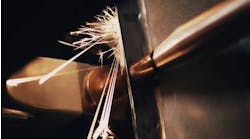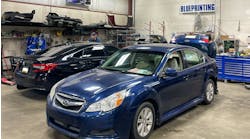Polyurethane was introduced in the mid 1970s as the first flexible material for bumper fascia applications. When federal safety regulations mandated energy absorbing bumper systems for the first time in 1973, manufacturers initially resorted to energy absorbing mounts for steel bumpers. These bumpers, sticking out from the car bodies by a foot, weren’t very aesthetically appealing, so efforts were made to hide the energy absorbing components behind a flexible plastic cover that was more integrated with the car’s bodywork.
The 1973 Chevrolet Corvette is the first example of this new type of construction. The Corvette was designed in the era of the metal bumper and models were retrofitted with urethane covers when the federal mandates came into effect.
Thermoset polyurethane has a couple of drawbacks that caused the OEMs to explore other options for bumper fascia material. First of all, polyurethane resin is somewhat expensive and is more messy and difficult to process than thermoplastic resins. More importantly, however, is the fact that thermoset urethanes cannot be directly recycled. That’s why more than 95 percent of bumper fascia today are molded of polypropylene blends. Polypropylene (PP) is less expensive and easily recyclable.
Although it has largely been supplanted by PP blends as the material of choice for bumper fascia, polyurethane is still being used. Polyurethane (PUR) tends to be used more often on luxury cars or other cars with lower production volumes for a couple of reasons. First, urethane provides a better painted surface finish, despite major improvements by TPO in recent years. Second and most importantly, due to their lower injection pressures, the tooling cost for creating urethane parts is less than that for creating thermoplastic parts, making it easier to break even on the cost of the tool.
These PUR bumpers are usually expensive and thus present a great repair opportunity. Urethane’s natural color is clear or yellow, but may be molded in virtually any color. Some late model bumper covers are gray, which may cause some confusion with TPO during the identification process. The best way to tell a gray urethane apart from TPO is to try to melt the bumper on the backside with a hot welder tip. If thermoset urethane is touched with a hot iron, the material with smoke and bubble immediately whereas TPO will melt cleanly.
Due to their relatively high surface energy, urethane is easy to repair with a variety of adhesives. Its flexibility, however, presents a challenge for repair and refinish materials alike. Fortunately, there are a wide variety of adhesives available for the repair of urethane on the market. Two-parts are the most popular type of adhesive for the repair of urethane. Hot-melts are also very common and have their own advantages over two-parts. Fusion welding with a nitrogen plastic welder is out of the question as urethanes are thermoset, or non-meltable plastics.
Polyurethane is the only type of thermoset plastic that can be repaired with an airless plastic welder. It may seem strange to consider repairing thermosets with heat when thermosets are not meltable. However, when repairing thermoset urethanes with a plastic welder, you are NOT using the heat to melt the base material. You are simply using the heat of the welder to melt and apply a thermoplastic urethane filler rod.
Let’s say you have a crack in a thermoset urethane bumper cover that you want to repair. After you clean the plastic, you’ll want to realign it and hold it in place while you do the hot-melt or “weld” repair. If the plastic panel is distorted, you can take advantage of urethane’s “memory” by heating the part with a heat gun or some other source of heat as described in Section 4B.
Grind a V-groove halfway through the backside of the plastic using either a Dremel tool or a coarse sandpaper disc. Once again, because thermoset urethane is not meltable, you cannot melt the V-groove in with a hot tool; the V-groove must be machined in with a grinder or with sandpaper. V-grooves in urethane do not need to be very wide; 1/4-inch to 3/8-inch (5mm to 10mm) is sufficient.
After removing the plastic with the grinder, sand inside the v-groove and round off the sharp edges with 80 grit sandpaper. It’s a good idea to sandscratch an area at least 1/4-inch on either side of the v-groove to allow for better adhesion at the edges of the hot melt adhesive. If there is any paint in the area, remove it with sandpaper also. Once you’ve finished sanding the area, remove the sanding dust with clean, dry compressed air or with a clean cloth.
Now that you’ve finished preparing the V-groove on the backside, apply aluminum tape or use clamps to line up the damage on the frontside. Cyanoacrylate adhesive can also be useful for tacking parts together for welding if the crack fits tightly together. Once the damage is aligned and the backside is v-grooved and sanded, you’re ready to begin the welding process.
Preheat the airless plastic welder to the proper temperature for the urethane welding rod as indicated on the temperature control dial. The temperature of the welder can vary during the welding process. Run a few inches of welding rod through the welder tip before applying the filler rod to the repair area. This will help stabilize the welder’s temperature as it is usually slightly too hot to start with. If the welder’s temperature is too hot, the urethane rod will bubble and smoke. Ideally, the rod should come out of the bottom of the welder tip melted, but clear and smooth with no bubbling. If the rod doesn’t cool down slightly after running a couple inches of rod through it, reduce the temperature slightly, let the welder cool for a few minutes, then try again.
Do not attempt to fill the entire length of the v-groove in one pass. It’s easier to apply the urethane hot melt in short segments, each about 1 to 1-1/2 inches long. The reason for this is that it’s easier to smooth out the rod while it’s still hot and somewhat liquid. If you do an entire 6-inch crack in one pass and go back to the beginning to smooth it out, it will already be cool and hardened.
After doing a 1- to 1-1/2-inch segment, remove the welding rod from the welder tip and go back over the welding rod you just deposited and smooth it out with the flat part of the welding tip. You can touch the base material with the hot welding tip briefly, but don’t let the heat linger. If you overheat the thermoset urethane base material, it will break the plastic down chemically, resulting in a slippery plasticizer coming to the surface. If this happens, the only way to recover is to grind the urethane down past the heat-damaged layer into some virgin material and reapply the hot-melt.
After smoothing out the first segment of rod, repeat the process for another segment. Continue this process until you have the entire length of the v-groove on the backside filled and smoothed out. Allow the welding rod to cool completely before working on the frontside. This usually takes about 10 minutes, but the process can be accelerated by force cooling the weld with water. By spraying cool water directly onto the weld or applying it with a wet sponge, you can begin working on the frontside immediately. This is one of the advantages that hot-melt adhesives have over two-parts.
Remove the tape on the frontside that you used to align the damage. Using a die grinder or a coarse sandpaper disc, grind a v-groove halfway through the plastic on the frontside, identical to the one you did on the back. Since you’ve already welded the backside, it will be hard to tell exactly when your v-groove is halfway through the plastic, so keep digging the groove in until you start getting into some of the hot-melt adhesive you applied from the other side. Again, V-grooves in urethane do not need to be very wide; 1/4 inch to 3/8 inch (5mm to 10mm) will be plenty.
After removing the plastic in the V-groove with the die grinder, sand inside the V-groove and round off the sharp edges with 80 grit sandpaper. With the 80 grit sandpaper, feather back the paint around the v-groove for at least 1/2 inch all around. A DA (dual-action) sander is good for feathering back the paint. Once you’ve finished sanding the area, remove the sanding dust with clean, dry compressed air or with a clean cloth.
Apply urethane hot-melt welding rod into the v-groove using the same process that you used on the backside — weld in short segments and smooth out the rod onto the surface while the welding rod is still hot and liquid. On the frontside, it is not necessary to crown the welding rod excessively as you will need to grind any excess material off anyway. It is better to smooth the molten rod out as flush as possible.
Because thermoplastic urethane welding rod does not feather out smoothly on the surface when sanded, you will need to cover the repaired area with a two-part filler. To do this, you’ll need to grind the urethane welding rod slightly flush with a coarse sandpaper, then skim coat with the two-part filler of your choice. Epoxy two-parts are easier to sand than urethane two-parts, so they are the product of choice for this type of application.
The bottom line is to not be afraid of “the yellow plastic.” It can be repaired profitably, but since it is not meltable, it does require a different technique than is used on the more common polypropylene bumpers.



